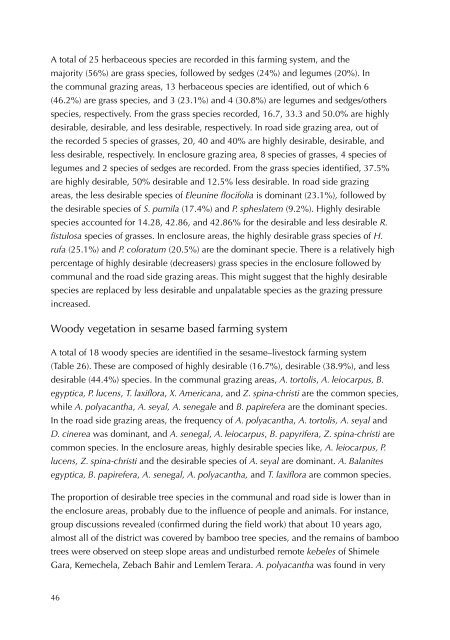Rangeland condition and feed resources in Metema District, North ...
Rangeland condition and feed resources in Metema District, North ...
Rangeland condition and feed resources in Metema District, North ...
You also want an ePaper? Increase the reach of your titles
YUMPU automatically turns print PDFs into web optimized ePapers that Google loves.
A total of 25 herbaceous species are recorded <strong>in</strong> this farm<strong>in</strong>g system, <strong>and</strong> the<br />
majority (56%) are grass species, followed by sedges (24%) <strong>and</strong> legumes (20%). In<br />
the communal graz<strong>in</strong>g areas, 13 herbaceous species are identified, out of which 6<br />
(46.2%) are grass species, <strong>and</strong> 3 (23.1%) <strong>and</strong> 4 (30.8%) are legumes <strong>and</strong> sedges/others<br />
species, respectively. From the grass species recorded, 16.7, 33.3 <strong>and</strong> 50.0% are highly<br />
desirable, desirable, <strong>and</strong> less desirable, respectively. In road side graz<strong>in</strong>g area, out of<br />
the recorded 5 species of grasses, 20, 40 <strong>and</strong> 40% are highly desirable, desirable, <strong>and</strong><br />
less desirable, respectively. <strong>in</strong> enclosure graz<strong>in</strong>g area, 8 species of grasses, 4 species of<br />
legumes <strong>and</strong> 2 species of sedges are recorded. From the grass species identified, 37.5%<br />
are highly desirable, 50% desirable <strong>and</strong> 12.5% less desirable. In road side graz<strong>in</strong>g<br />
areas, the less desirable species of Eleun<strong>in</strong>e flocifolia is dom<strong>in</strong>ant (23.1%), followed by<br />
the desirable species of S. pumila (17.4%) <strong>and</strong> P. spheslatem (9.2%). Highly desirable<br />
species accounted for 14.28, 42.86, <strong>and</strong> 42.86% for the desirable <strong>and</strong> less desirable R.<br />
fistulosa species of grasses. In enclosure areas, the highly desirable grass species of H.<br />
rufa (25.1%) <strong>and</strong> P. coloratum (20.5%) are the dom<strong>in</strong>ant specie. There is a relatively high<br />
percentage of highly desirable (decreasers) grass species <strong>in</strong> the enclosure followed by<br />
communal <strong>and</strong> the road side graz<strong>in</strong>g areas. This might suggest that the highly desirable<br />
species are replaced by less desirable <strong>and</strong> unpalatable species as the graz<strong>in</strong>g pressure<br />
<strong>in</strong>creased.<br />
Woody vegetation <strong>in</strong> sesame based farm<strong>in</strong>g system<br />
A total of 18 woody species are identified <strong>in</strong> the sesame–livestock farm<strong>in</strong>g system<br />
(Table 26). These are composed of highly desirable (16.7%), desirable (38.9%), <strong>and</strong> less<br />
desirable (44.4%) species. In the communal graz<strong>in</strong>g areas, A. tortolis, A. leiocarpus, B.<br />
egyptica, P. lucens, T. laxiflora, X. Americana, <strong>and</strong> Z. sp<strong>in</strong>a-christi are the common species,<br />
while A. polyacantha, A. seyal, A. senegale <strong>and</strong> B. papirefera are the dom<strong>in</strong>ant species.<br />
In the road side graz<strong>in</strong>g areas, the frequency of A. polyacantha, A. tortolis, A. seyal <strong>and</strong><br />
D. c<strong>in</strong>erea was dom<strong>in</strong>ant, <strong>and</strong> A. senegal, A. leiocarpus, B. papyrifera, Z. sp<strong>in</strong>a-christi are<br />
common species. In the enclosure areas, highly desirable species like, A. leiocarpus, P.<br />
lucens, Z. sp<strong>in</strong>a-christi <strong>and</strong> the desirable species of A. seyal are dom<strong>in</strong>ant. A. Balanites<br />
egyptica, B. papirefera, A. senegal, A. polyacantha, <strong>and</strong> T. laxiflora are common species.<br />
The proportion of desirable tree species <strong>in</strong> the communal <strong>and</strong> road side is lower than <strong>in</strong><br />
the enclosure areas, probably due to the <strong>in</strong>fluence of people <strong>and</strong> animals. For <strong>in</strong>stance,<br />
group discussions revealed (confirmed dur<strong>in</strong>g the field work) that about 10 years ago,<br />
almost all of the district was covered by bamboo tree species, <strong>and</strong> the rema<strong>in</strong>s of bamboo<br />
trees were observed on steep slope areas <strong>and</strong> undisturbed remote kebeles of Shimele<br />
Gara, Kemechela, Zebach Bahir <strong>and</strong> Lemlem Terara. A. polyacantha was found <strong>in</strong> very<br />
46

















